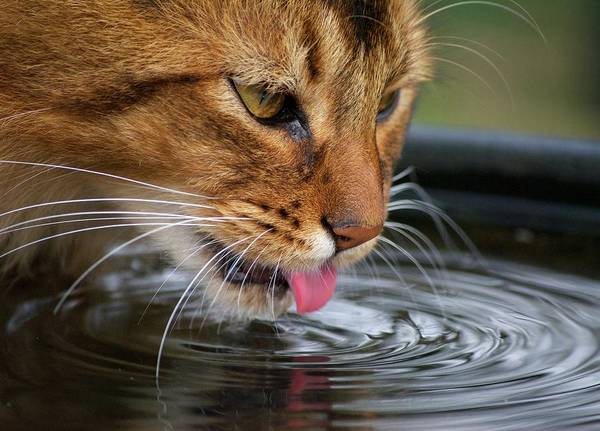
by Margejane | Cat Accessories, Featured
A cat water fountain is a motorized pump that circulates water via a series of filters (or a single filter). It pushes the water up into a fountain stream or bubbler. This system of water movement helps to keep it clean, cool, and aerated – providing water that tastes fresher and better to your feline buddy.
Why should you get a cat fountain?
Your cat needs to drink more water every day, especially if they are on a dry food diet. A cat fountain is one great way to ensure your cat stays hydrated all day long. Cats, as it has been discovered, are naturally attracted to trickling or running water. Hence, a water fountain is a good investment to encourage a good drinking habit for your cat.
Adequate hydration will consequently improve nutrient absorption, enhance better digestion, and assist to flush out bacteria and toxins that can accumulate in your cat’s digestive and urinary tract. Has your cat ever suffered a urinary tract infection in the past? Then you should get her a cat fountain to avoid future infections.
Bonus pro: Are you tired of your cat going to drink from the toilet or sink all time? A cat water fountain is also an effective solution to encourage your cat to hydrate from their water bowl instead of the toilet bowl.
How often should you change the water in your cat’s fountain?
Your cat fountain should be cleaned every 3 – 4 days for several cats and about 5 – 6 days for just one cat. You should consider the number of cats you have, as well as if they have short or long hair. Keep in mind that long-haired cats will typically want more frequent cleaning.
Top 5 cat fountains
Do you have a picky drinker? Well, not anymore! The Catit Flower Pet Fountain is a colorful and inviting water bowl that is sure to be your cat’s favorite. It is an innovative fountain that features a unique and customizable design, encouraging your buddy to drink more water to keep her hydrated and healthy.
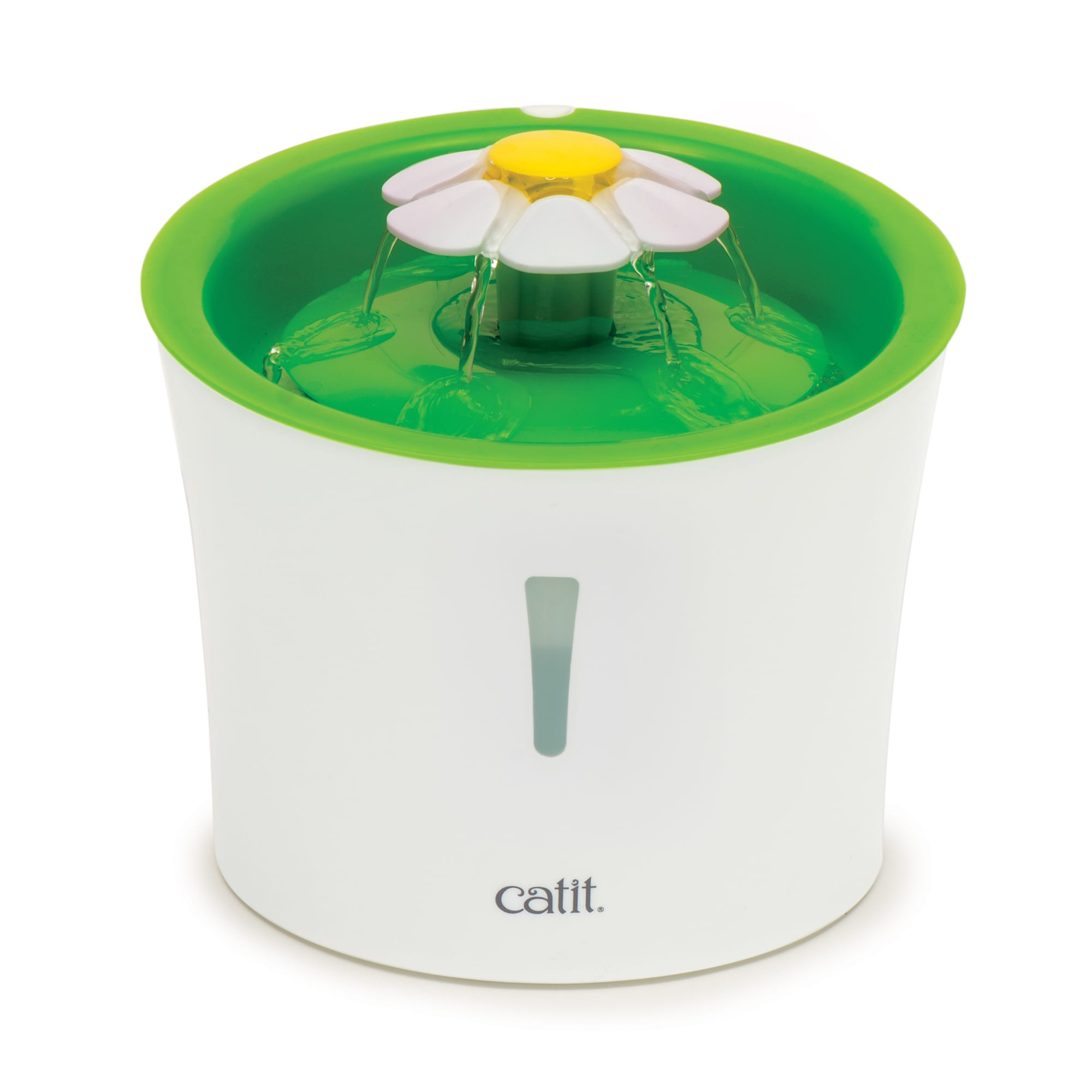
It comes with 3 water flow settings, so you can switch between a faucet-like stream, a bubbling top, or a calm flow of water. So enticing your fussy pet to have a drink has never been easier. While your cat enjoys a continuous flow of cool water, there’s a triple-action filter that removes dirt, odors, calcium, and magnesium. Unlike other cat water fountains, this beauty does not give room for debris to settle in and build up. Instead, your cat is always drinking from a clean, hygienic container. We call this flower magic!
Get Catit Flower Waterer at the best price here
The Frisco Gravity Refill Pet Waterer is no ordinary water bowl! It’s a unique self-replenishing oasis that provides seemingly endless hydration for your pet. One amazing thing about the gravity waterer is how it automatically refills the reservoir after your pet drinks, making you rest assured that they won’t be left thirsty when you’re out working (or partying, lol). It features a water bottle on top that has a very large opening for easy refilling and cleaning, and a base with easy-to-lift fitted handles, allowing you to move the water fountain to wherever you want in your home.
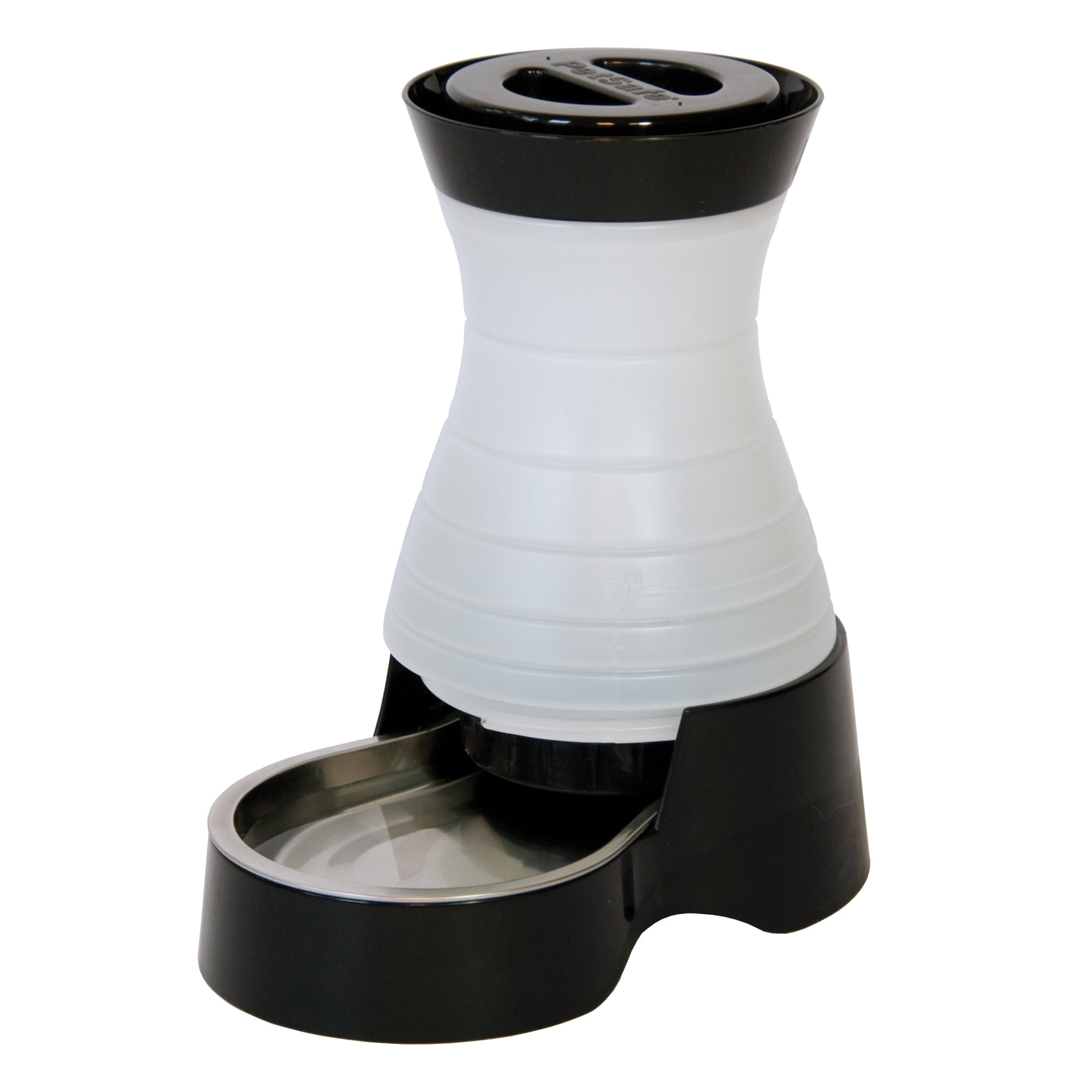
The Frisco Gravity water fountain is a perfect product for daily use for cats of all ages, and even other pets as well – from gerbils and hamsters, rabbits, and ferrets to dogs. It comes in a variety of different sizes so you get to pick whichever one best suits your cat’s needs.
Get Frisco Gravity Refill Pet Waterer at the best price here
This product has been designed to increase your pet’s desire to drink more water by exemplifying a natural water source, rather than some boring, stagnant water bowl. It has the capacity to hold a gallon of water, which makes it suitable for owners of multiple pets. In addition, the stainless steel construction offers great resistance to bacteria and makes maintenance simple. In fact, it can be thrown into a dishwasher (excluding the pump)!
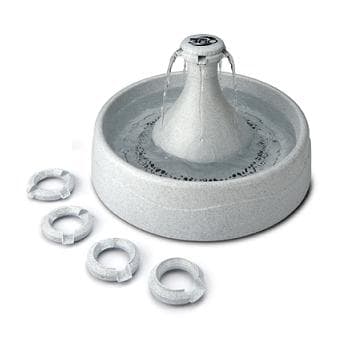
It also has rubber feet that prevent sliding and adjustable flow control to minimize splashing. In all, this product is a good choice for both small pets and large, giant breeds.
You can get this amazing product here

The PetSafe Sedona Pet Water Fountain is an elegant water-container upgrade that is perfect for households with many pets. It features a large drinking dish that allows multiple pets to drink at the same time, and it accommodates pets of all sizes. It utilizes a super-quiet pump, so your skittish cats won’t be afraid to approach the water fountain. The PetSafe Sedona Pet Fountain has been manufactured with a sleek design, featuring a ceramic tower and force-resistant transparent plastic dish that reduces spills and splashes. More importantly, it features a replaceable foam filter that captures debris and hair, and an activated carbon filter that removes odors and bad tastes. It is also dishwasher safe (only the top rack).
You can buy this stylish product at the best price here
5. Cat Mate Shell Plastic Pet Fountain
With the capacity to hold as much as 100 ounces of water, the Shell Plastic Pet Fountain by Cat Mate is sure to provide your furry pet with an enjoyable flow of clean water. It features multi-height water drinking platforms with a shell attachment which forms a stream of naturally oxygenated, cold water to entice your “paw-toner”. This innovative water fountain offers 3 stages of filtration, thereby preventing unhealthy debris deposits. It also has minimum and maximum water level indicators so that your cat never goes to an empty fountain with an alarming sound that goes off when the water level is down. You can get this product with free shipping when you use the button below.
Get the best pricing here.
Summary
So there you have them: the 5 top cat fountains for your sunshine. Getting a cat water fountain is a prerequisite for maintaining a long and healthy life for your best bud. To get any of the above amazing products at the best price, use the button below.
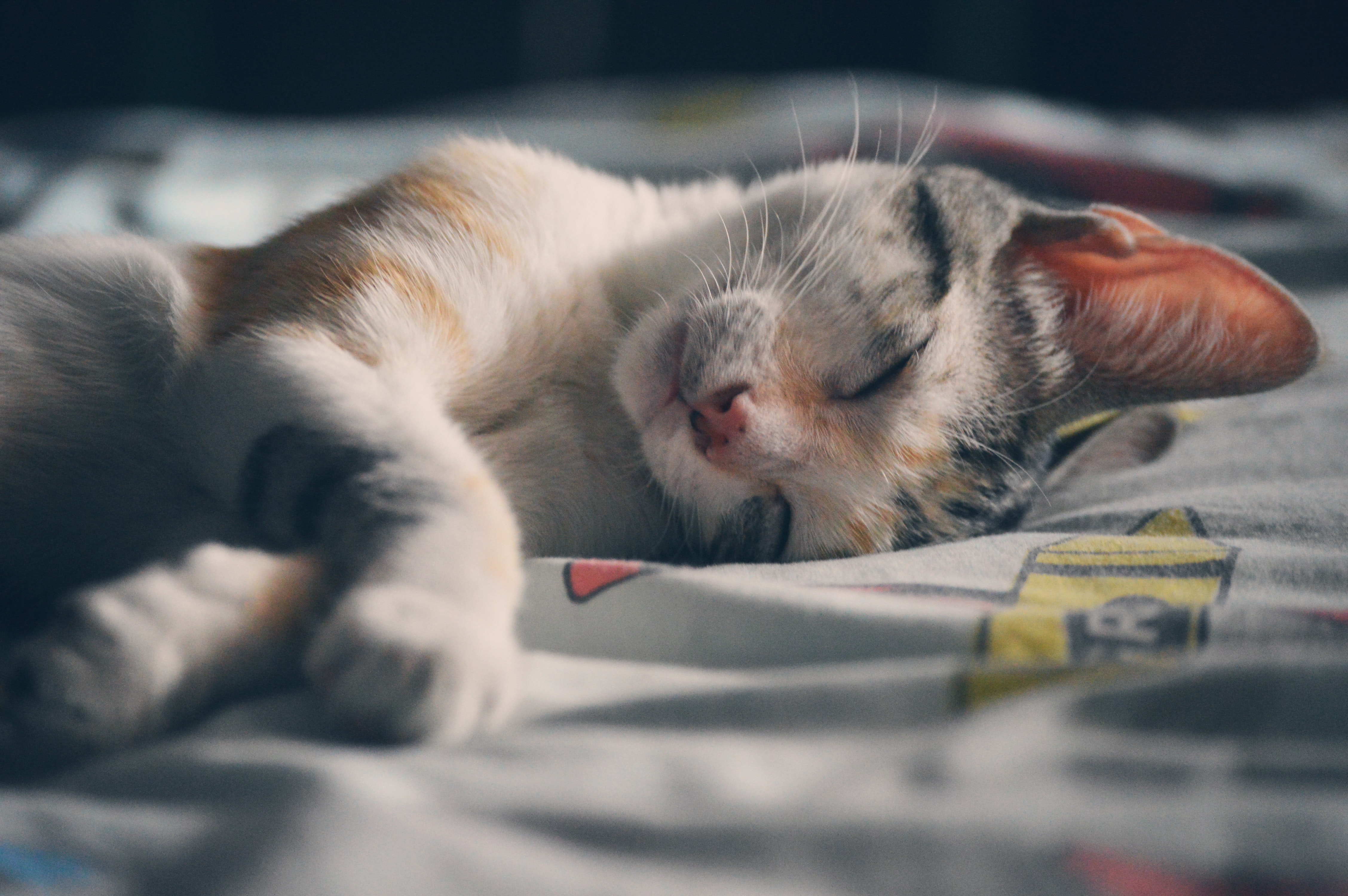
by Margejane | Cat Accessories, Cat Health
There was a time not all that that long ago when a cat’s lifespan was such that an 8-year-old cat was considered to be a senior. Today, this is no longer the case. The life expectancy of cats has increased considerably thanks to better nutrition, living safely indoors, and better veterinary care. Indeed, a cat’s lifespan indoors averages 13 to 17 years, and many cats even live into their 20’s!
CARING FOR YOUR SENIOR CAT
Contrary to popular opinion, growing older is not a disease. Some older cats are more susceptible to different conditions, and some older cats are perfectly fine.
A cat’s lifespan is generally longer if the cat is kept safely indoors. The basic needs of your cat are fairly simple. You love your cat and you want your cat’s lifespan to be long. First, a comfortable sofa bed in a cozy, pleasantly warm area of your home is essential. A litter box that is kept clean and is easily accessible, preferably with lower sides. Clean water and quality cat food (ask your vet for a recommendation)is necessary…in general, the best food is grain-free food that has high moisture content.
AS a rule, a grown cat is fed twice a day unless otherwise instructed by your veterinarian. Kibble should be given at your vet’s discretion, as it may be detrimental to a senior cat’s health. I always add L-Lysine to my cats’ wet food once daily, as it boosts a cat’s immunity. You may need to keep food and water in more than one place, and sometimes a second litter box is advisable.
Be sure to see your veterinarian regularly. On average twice a year for a healthy cat is recommended. I can’t emphasize this enough. A complete physical exam can assure you your cat is healthy, or detect any issues hopefully before they become serious.
Make life easier for your senior cat. Purchase pet steps so your cat doesn’t have to (or can’t) get on your bed. Create box steps so your cat can reach its favored spots.
For the safety of both you and your senior cat, keep a quality night light on.
A SENIOR CAT’S SPECIAL NEEDS
Just like humans, cats are individuals who can begin to experience age-related physical changes as they age. It is most likely that some cats may encounter these changes between 7 and 10 years of age, and most do when they reach 12. Here’s how a cat ages when compared to a human:
CATS HUMANS
1 yr old 16
2 yr old 21
3 yr old 25 10 yr old 53
12 yr old 61
And a 15-year-old cat is 73 in human years!!
• As your cat ages, there can be many physical and behavioral changes. An older cat is less effective at grooming itself which can result in matting, inflammation and skin odor. An older cat’s skin is thinner and less elastic and is more prone to infection. It also has reduced blood circulation.
• An older cat’s immune system is less able to fight off infection and disease.
• Hearing loss is common in older cats.
• Arthritis is common in older cats
• Hyperthyroidism – Hyperthyroidism is fairly common in cats 13 years old and older. It is quite uncommon in cats 10 years old and younger, with only 5% becoming hyperthyroid.
What is hyperthyroidism? Hyperthyroidism is the overproduction of thyroid hormones by the thyroid glands.
Signs of hyperthyroidism may be subtle and then increase in severity as the disease progresses. Signs include weight loss, increased appetite, increased thirst, and urination. If treated properly and early, a cat may make a full recovery.
TREATMENT FOR HYPERTHYROIDISM
There are 4 treatment options:
1. Radioactive iodine therapy
2. Medication
3. Surgery
4. Dietary therapy
In RADIOACTIVE IODiNE THERAPY, it is injected under the skin and concentrates in the thyroid gland, destroying overactive thyroid cells.
MEDICATION – Methimazole is used to treat hyperthyroidism in cats.
SURGERY – removal of the thyroid gland (thyroidectomy) has a good success rate and most likely is a permanent cure.
DIETARY THERAPY – prescription food that is iodine-restricted can help, but the effects of long-term iodine restriction is still being studied.
It’s important to note that cats with hyperthyroidism on this diet CANNOT be fed anything but their prescription food.
CHRONIC KIDNEY DISEASE
kidney disease (CKD) is the persistent loss of kidney function over time. CKD occurs in cats of all ages, but is most common in older cats and occurs in approximately 3 out of 10 geriatric cats.
Kidneys perform a variety of vital tasks:
• Eliminate protein wastes
• Balance body water, salts, and acids
• Produce quality urine
Kidney disease impairs kidney function.
There are two types of kidney diseases:
1. Chronic kidney disease – here kidney function declines slowly. Mild signs of chronic kidney disease do progress as kidney disease worsens.
2. Acute kidney disease – if a cat suffers an injury to the kidneys, it may become very seriously ill and stop urinating completely. Death often follows.
Early signs of mild kidney disease include frequent thirst and urination. Sometimes the cat owner doesn’t realize how much kitty is drinking, but if the litter box has an unusually large amount of clumped litter (if you are using clumping litter) or large pools of urine, that warrants a trip to the vet as soon as possible.
Signs of severe kidney disease may show:
• Vomiting
• Weight loss
• Increased urination and thirst
• Decreased appetite
Your cat may sleep more and groom less.
There are risk factors that can initiate kidney disease, such as infection, kidney stones, blockage of the urethra (the tubes leading from the kidneys to the bladder), cancer, polycystic kidney disease (polycystic kidney disease (PKD) is an inherited condition in cats.) It causes multiple cysts (which are fluid-filled pockets that form in the kidneys.) These cysts are present from birth, and at first, are quite small but increase in size over time and eventually, they may impair kidney function.
If you suspect your cat may have CKD, take him to your vet as soon as possible.
A frequent question is: “What is the life expectancy of cats with chronic kidney disease?” The cat’s lifespan can vary depending upon how well kitty responds to treatment in the initial stage of the illness, and the quality of follow–up care. Treatment is encouraged – many cats do have a good quality of life and can live as long as four more years. From my personal experience, I can tell you that my 17-year-old cat has had CKD for about 2 years now and got a good bill of health at a recent vet checkup.
1. Because senior cats are harder to find homes for, you’re saving a life and giving a senior cat a loving home.
2. Senior cats are calmer and more relaxed and less likely to get into trouble.
3. Senior cats tend to be good about using a scratching post and not your furniture.
4. Senior cats are good at using the litter box.
5. Senior cats have longer and better attention spans and are easier to train.
6. A senior cat’s personality is already developed, so you know what you’re getting and if he/she is a good fit.
7. Senior cats seem to be very thankful for being adopted.
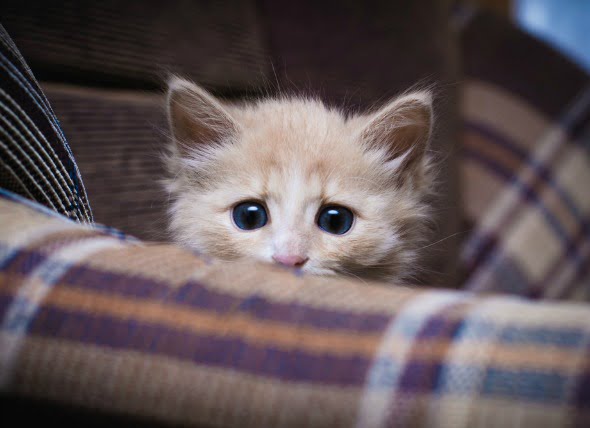
by Margejane | Cat Accessories
If you need to travel with your cat there are steps you should take to ensure your cat’s safety. This info is regarding traveling by car with your cat.
One of the most important things you must do for a safe trip is to keep your pet cool. In the summer, you need to make sure your car is air-conditioned. Just a few minutes in a hot car can lead to heatstroke or death. If your cat is especially susceptible to getting overheated (for example, Persians because they have long hair and short noses), you should freeze cool packs, wrap them in a thin towel or cloth, and place them in the bottom of the carrier. Keep some extra cool packs in a small ice chest.
NEVER leave your cat alone in your car in the sun or shade for even a few minutes. A cat can get overheated and very sick in only a few minutes.
HAVE A TRAVEL CHECKLIST
- Have your cat’s medical records with you. You should also have a current health certificate and your vet’s phone number. If the trip causes a flareup of a health problem, these documents are crucial.
- Current Photo of your Cat. Heaven forbid kitty gets lost, you need a good photo. Be sure you can make copies if necessary. If your cat has any identifying marks, write them down.
- Disposable Litter Pans – These are a godsend when traveling. Amazon sells a variety of them, some even have the cat litter included. To avoid a mess, use just about ½” litter in the pan – that’s adequate.
- Cat Food – You need to keep your cat on his regular food. A sudden change in diet could cause a bout of diarrhea. Because some areas of the country may not sell your cat’s regular cat food, be sure to pack enough of your cat’s regular cat food.
- Harness – Purchase a proper fitting H Type harness. This is secure and comfy for your cat.
- Cat Carrier – A quality hard plastic carrier is the best suited for travel – sturdy, easy to clean and allow for good air flow.
- Retractable Lead – the smallest size should be best. This works well when you take a break on your trip and want to let your cat get some air. (Be sure to attach the lead with the car doors closed.)
- Water Bowl and Water – A metal bowl and a supply of water bottles, preferably the water he is used to initially (there is a difference!)
IMPORTANT – Make sure your cat is microchipped.
So get everything ready that kitty needs and happy travels!
MOVING
Needless to say, moving is a very stressful experience for humans and even more stressful for your feline companions. By doing a few simple things you can help keep your cat safe and secure during your move.
First, you need a secure room for your cat. During your move doors will be opened constantly, an ideal opportunity for your cat to bolt and run out of the house. To prevent problems, either board kitty (I know I don’t like boarding, do that only if absolutely necessary and only for one night if possible) during the move or set up a secure room for your cat. If you have an extra bathroom, consider putting a soft bed, food and water and a litter box in that room. Put a “DO NOT ENTER” sign on that bathroom’s door and be sure to inform your movers that absolutely no one is to enter that room. It’s also a good idea to keep a radio with either a talk station or soft music on in the bathroom to keep kitty calm, help him sleep and block out some of the outside noise.
Home sweet home – Once you’re in your new home, set up a room just for your cat for about a week. Keep your kitty confined while you’re going in or out while unpacking as well. Spoil your cat to make him happy in his new home, perhaps with treats or his favorite food. He’ll be less inclined to bolt.
Be sure to put a name tag with your new address and phone numbers on your cat’s collar.
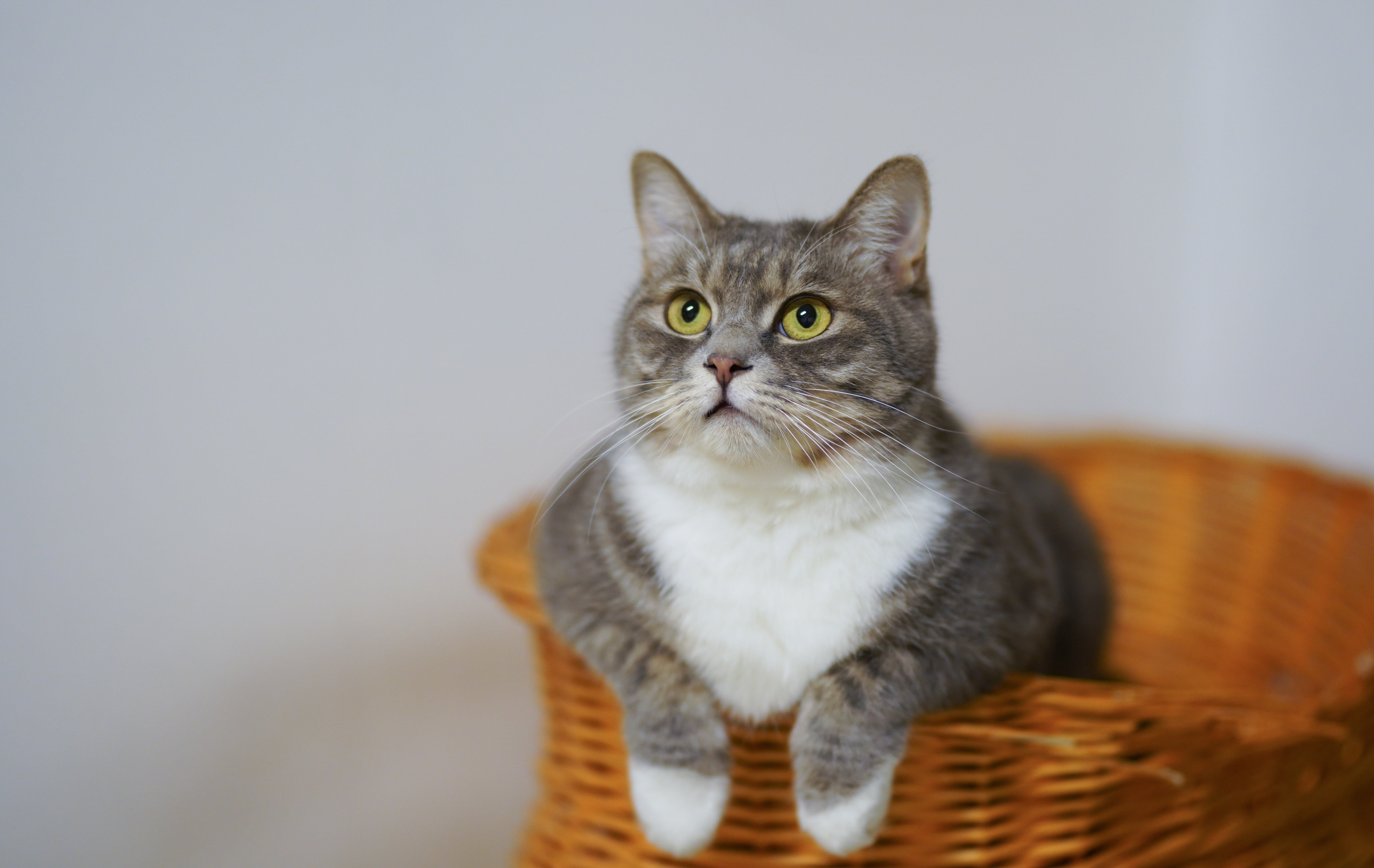
by Margejane | Cat Accessories, Cat Food & Treats, Cat Health
Cats are a common sight in many households. These felines are known to be warm, furry and friendly. Children especially derive joy from having a pet in the home, particularly if it is a cat. However, even within households, cats are exposed to danger. No one would want his or her cat to get hurt, sick, weak or even die (in the most extreme cases). Therefore, it is imperative that you identify, isolate and mitigate the common household dangers cats face. The truism ‘prevention is better than cure” is very appropriate and is definitely applicable in this case.
The fact is anything that has the potential to poison, harm, maim, disfigure, cut, burn, scald or shock a cat or kittens can be and should be classified as a potential danger. Knowledge of these dangers and their mitigation can help save the life of the family cat loved and adored by all, avert unscheduled visits to the vet, cut down on unforeseen vet bills and head off a sad untimely end. The following are at least 8 common household dangers for cats, so be sure to look out for them:
1- Human Foods: Grapes, raisins, avocados, garlic, and products containing xylitol (categorized as a sugar alcohol and present in small amounts in some vegetables and fruits), can seriously disable our furry friends. In addition to this chocolate when ingested by cats can cause vomiting, diarrhea, and seizures. Ensure all these foods are kept out of reach.
2- Chemicals and Poisons: These include bleach, detergents, disinfectants, antifreeze, garden fertilizers, rodent poisons. If these are ingested or inhaled by cats (even in small quantities), they can cause serious life-threatening problems and chemical burns. If for instance, disinfectant is used on kitchen cookers as well as flat surfaces like tabletops, towels should be used to dry it up immediately before cats get to walk on the surface or even lick them. Also always keep the toilet seat down as powerful chemicals are also used to keep it clean and kill germs. Furthermore, it is dangerous and sometimes catastrophic, when people mistakenly apply flea and tick products to the wrong species (products meant for dogs are used on cats and vice versa). The best way to avoid this is to read labels correctly and consult your vets before starting a flea and tick eradication program or exercise.
3- Human Medications: Prescriptions, over the counter drugs like pain killers, cold meds, anti-depressants, and dietary supplements, are probably the most dangerous category of threat in the home. Cats can grab pills from containers or eat meds accidentally dropped on the floor. So it is essential to lock them away in cabinets or places they (cats) have no access to. Childproof latches will really come in handy in case your cat is a problem solver.
4- Plants: Some plants are poisonous to cats especially lilies which causes life threatening kidney failure even in minute amounts. Holly, mistletoe, Christmas trees (used on special occasions like holidays) and Christmas tree water are all lethal to cats. Furthermore, decorations like tinsel, ribbons, fake grass, balloons, candles, snow globes, and lights should all be securely stowed away as they can cause intestinal blockages to cats if ingested. Snow globes especially contain toxic chemicals. Turkey bones as well can cause choking so food in plates should be stashed away and never left uncovered or unattended.
5- Dangerous Objects: Rubber bands, hair ties, earbuds, yarn, and dental floss. These may be harmless to us as humans but if swallowed by cats will result in intestinal blockages and even death. Plastics like cellophane bags can even choke cats. Therefore freshly bought groceries should be put away as quickly as possible and plastic bags tucked in a safe hiding place like drawers. Toys with strings should also be kept out of reach of cats.
6- Fireworks: The resulting loud sounds and bright flashes from fireworks tend to startle and frighten cats. Consequently, it is wise to be aware of this and apply prudent measures to curtail or avoid these entirely.
7- Fire Hazards: Items and products used in the home like cooking gas and gasoline for generators and cars are all potential fire hazards if not carefully handled. Gas can choke cats to death while fires will no doubt lead to fatalities. Ensure all necessary safety measures are applied. Furthermore, ensure your windows have Pet Alert stickers on them depicting which rooms have pets in them in case of a fire outbreak. This would enable emergency first responders (like firefighters) pinpoint rooms where the pets are located and rescue them.
8- Miscellaneous Hazards: These include cords of window blinds which potentially could strangle cats. These should be coiled and kept out of reach. Ensure all windows screens are securely fastened and latches locked down. Washers and dryers (washing and drying machines) should be kept closed at all times when not in use. Furthermore, as an additional safety precaution ensure you carry out visual inspection of the machines before turning them on as cats have been known to be trapped within. This would prove fatal to the cats if the machines are turned on with the pets inside. Electrical wires are another high-risk hazard, as cats are sometimes known to chew on them. If plugged to an electrical outlet this could result in electrocution. Endeavor to hide the wires under carpets or rugs or encase them in tubing and coat them with something safe that tastes horrible to cats like bitter apple spray. Provide cats with safe alternatives like chewy toys coated with a flavor delicious to cats like tuna juice or paste. Kitchen utensils used in culinary preparations are also a potential danger. This is because they more often than not have sharp, serrated or pointed edges or ends which can accidentally cut, pierce, amputate or stab cats while being used in the kitchen. Also, be safety conscious when using them to avoid tragic incidents.
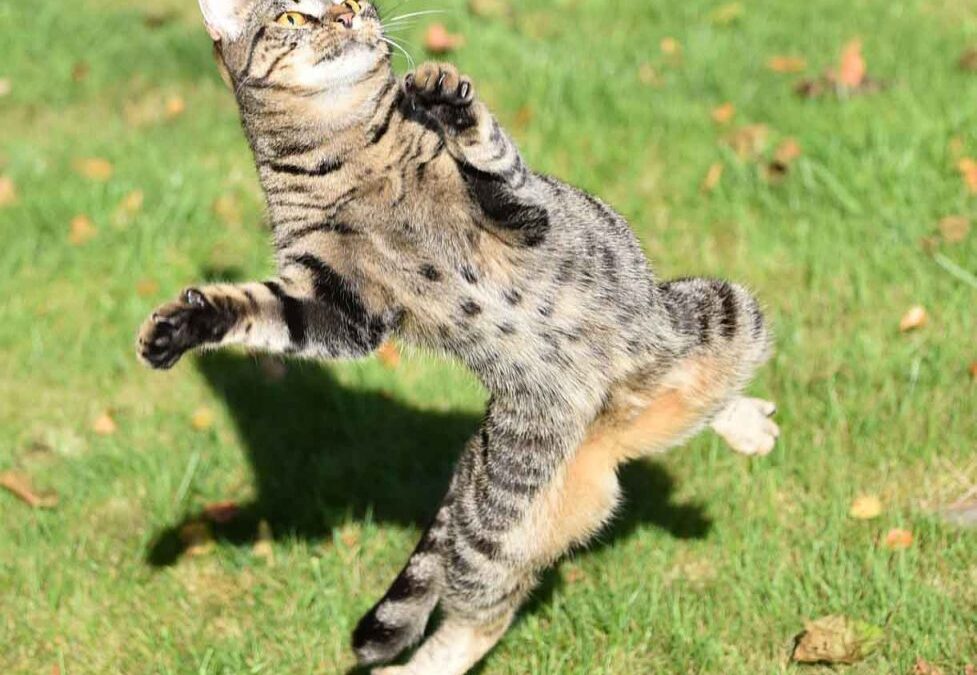
by Margejane | Cat Accessories
- Bowls – Ceramic or stainless steel. Do NOT buy plastic bowls as they can harbor bacteria. Before I knew this and used plastic bowls, one of my cats got acne!
$SAVINGS TIP$ — Pet stores are usually way overpriced when it comes to pet bowls. If you have any thrift shops near you see if you can find any nice ceramic or stainless steel bowls, about one cup size, in good condition. Instead of paying $7-$9 for a ceramic bowl liked I used to, I got an great assortment of bowls for 50 to 99 cents each!
Cats only need two bowls. It’s a good idea to have some extra cat bowls on hand so you can have some in use while you wash the others.
- Toys – Every cat or kitten needs toys. Here are some toy ideas to keep your kitty happily occupied.
Boxes – Take a large box and seal 3 sides. Cut an entryway on one side. Line it with a soft blanket or towel. Put a few small toys like catnip mice or balls inside.
Empty Thread Spools – These make great toys for your cat to bat around the house.
Rolled-up Sock –It’s an old sock to you but a great toy for your kitty! Sprinkle some catnip on the sock before rolling it up and watch the fun begin.
Aluminum or Paper Balls – Take some clean unused aluminum foil or scrap paper and roll it into balls for kitty to swat around the house.
CAUTION: NEVER let your cat play with plastic bags. Cats suffocate from plastic bags every year.
A string is fine for kitty to play with as long as he/she is NEVER left unsupervised. If kitty swallows string it can tangle in the intestines and kill him, so put all string away when playtime is over.
- Nail Clippers – A simple inexpensive pet nail clipper works fine. It has a slight concave shape at the bottom of the blade. Just gently press your cat’s paw on the underside in the center and the nails should extend. Clip off the white part of the nail. NEVER clip the pink part which has a vein. If you are a newbie and are nervous about the process, visit your vet and have a vet technician demonstrate the technique for you. There are also videos on YouTube regarding this subject.
- CARRIERS – It’s an absolute must to have a good carrier so your kitty will be safe traveling by any means, not to mention you don’t want to experience the horror of losing your cat.
There are many different types of carriers.
- CARDBOARD – this should only be used if you have no other option, such as when adopting your pet and you haven’t purchased a good carrier yet. Use it once and throw it away.
- CRATE – wire crates are NOT recommended. The cat is exposed on all sides which only adds to his fear because he can’t hide.
- SOFT-SIDED – I’ll admit I’ve used and still own a soft-sided carrier for my small cats. I have spinal problems and find it easier for me to carry it from underneath rather than use the straps. I only use it for a quick trip to the vet and put a seatbelt securely around it when driving. However, I do not recommend them for extended trips (my vet is just a few blocks away.)
- PLASTIC CARRIER – This is the best type of carrier. A quality carrier will last a lifetime, is sturdy, easy to clean, and lets your cat feel secure. When you go to purchase a plastic carrier, please make sure the door to the carrier is easy to open and lock. Be very careful in your choice. Years ago I bought what appeared to be a good quality carrier and my cat escaped from it because the door came off. Thankfully I was able to grab my precious kitty. Personally, I like carriers that also have a door on the roof.
HOW TO GET YOUR CAT USED TO HIS CARRIER
Now that you know which carrier to purchase, you also need to know how to get your cat used to it. Not an easy task! Here’s some information that should help.
Your normally calm cat can go crazy when you try to put him in the carrier. The good news is with a little practice it will be much easier. The first thing to do for a cat who has no crating experience is to take the carrier and remove the door if possible. If not, prop the door open. Put the carrier on the floor. If your house is a cat-only house, put treats all around the carrier in a 3-foot circle, plus some inside the carrier. When all treats are gone, repeat the process, but this time put the treats 2 feet around the carrier and some inside the carrier. Repeat until there’s no circle and all treats are inside the carrier. When your cat goes into the carrier to eat the treats, that’s progress! For the next day or two put some treats at the rear of the carrier.
Next choose a word you will use that your cat can identify as carrier. Bed, condo, anything. Show your cat his favorite treat to get his attention. Show him the treat and keep it near his nose so he can smell it. In a joyful voice use the word you’ve chosen and guide your cat to the carrier. When he’s near the carrier, say about a foot, reward him with the treat. Lavish him with praise. Move him a few feet from his carrier and repeat the process. When he’s okay with coming that close to his carrier, place a treat on the doorway ledge. Lavish more praise and petting on your cat. After that, toss a treat inside and let your cat go get it.
NEXT – Put the door back on the carrier. Repeat the previous exercise so he doesn’t get spooked. If he gets spooked, re-teach to the carrier on command. Things should go more smoothly this time around. Don’t worry if he notices the door, don’t fret. It may take another day or two but this method works.
Once your cat goes into the carrier, quietly close the door and lock it, all the while speaking softly and cheerfully, praising your cat. Throw some treats in the carrier, and then in a few minutes open the carrier door and let him come out if he wants. From then on your cat should go into the carrier without a problem.
![[How To] Giving Your Cat Medication](https://cutekittens.club/wp-content/uploads/2019/09/unnamed.jpg)
by Margejane | Cat Accessories
Giving your cat medication is usually pretty unpleasant. Fortunately, there are methods that can make the process easier.
Giving Your Cat a Pill
Sometimes giving your cat a pill may be as easy as hiding it in a bit of his favorite cat food or a small ball of cream cheese. Pill Pockets is another possible option – it’s a soft treat that is open on one end to put a pill in.
Cats are sometimes too smart for their own good and know you’re up to something they won’t like, and they will be completely uncooperative. In this case, another method needs to be tried. Get a large, thick bath towel. Wrap the kitty up in the towel until only his head is poking out. If you have someone to help you, so much the better, but you can do this on your own. Put the cat bundle on your lap with its head facing away from you. Reach over and using one hand, open your cat’s mouth. Reach over his nose and pressing the lips in, just behind the long fangs in front. Pressing at that point causes the cat to open his mouth.
Now, with your other hand, put the pill down on one side of the tongue. This will make the pill go down better. Once the pill is in his mouth, close his mouth, point the nose upward and stroke his throat until he swallows. If he starts licking his mouth or his nose, that means he’s swallowed. Keep him bundled and wait a few seconds because he may not have swallowed the pill yet and will spit it out.
Another method is what’s known as a pill gun or pill popper. It’s a plastic “plunger” with a rubber tip on the end where you can insert the pill while you keep your fingers out of harm’s way (your kitty’s teeth.) You can get one from your vet and are very inexpensive.
While your cat is securely bundled in a thick towel, insert the pill popper into his mouth. Be sure NOT to put it further than you can see. Once he swallowed the pill, lavish praise on him, give him a treat. Then slowly unwrap and release him. If you’re nervous about doing this, ask your vet to give you a demonstration.
If the pill doesn’t need to be swallowed whole, you can try crushing it and mixing it in food. You can buy a pill crusher or put the pill in between two paper towels and crush it with a hammer. Another option is to crush it with a spoon. Mix it well with your cat’s favorite and most flavorful food, maybe one with some gravy to make it tastier.
How to Give Liquid Medication
Dispensing liquid medication is far more difficult than pills. I have to laugh (although it wasn’t funny at the time) of how my late cat Wally who was as sweet as sugar, let the pink liquid medicine I thought he swallowed come out of his little drooling mouth. I wish I was better informed at the time so I’m happy to share what I have learned since then. Being a foster mom has its perks!
First, get a syringe without a needle from your vet. Spoons don’t work and are very messy – don’t use them. With a syringe, you are able to measure the exact amount of medication required, as well as giving you the ability to dispense a little at a time. Ask your vet to show you how to do this when he gives you the medication.
Wrap kitty in a thick towel the same way you would do if administering a pill. Speak softly to your cat and then reach over his head and place your thumb and index finger behind each of his big canine teeth. Your cat will open his mouth when you apply pressure there. Be 100% ready to insert the tip of the syringe into the corner of his mouth and depress the plunger. Put the syringe down and let your cat close his mouth. Point his head upward and stroke his throat so that he will swallow.
NOTE: Be careful NOT to squirt too much of the medication down your cat’s throat, because he might inhale some, which could potentially cause serious lung problems.
NOTE: Be sure NOT to lift your cat’s head up when giving him the medication – this could cause it to go down his windpipe.
NOTE: If your cat starts coughing and/or panicking, STOP EVERYTHING. Let him cough, let him spit out medication. Once he is over that, try again.
Another way to try giving liquid medication is to put a little on the top of his front paws. Your cat should hopefully lick it off.
How to Apply Topical Medication
Put a dab of margarine or petroleum jelly on each front paw. Licking it off should help your cat to relax. While he’s occupied put the topical medication where it needs to be. If all else fails buy a “cone of shame” for your kitty to wear around his neck. He won’t like wearing it but be assured he’ll get over it once it’s removed. The bottom line is, he’s got to heal.
I hope this information helps you when medicating your kitty. Be sure to consult with your veterinarian before attempting to give your cat medication to ensure you are doing things correctly.










![[How To] Giving Your Cat Medication](https://cutekittens.club/wp-content/uploads/2019/09/unnamed.jpg)
Recent Comments